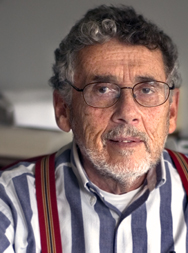Philip Eaton on:
[Wikipedia]
[Google]
[Amazon]
 Philip E. Eaton (born 1936) is a Professor Emeritus of
Philip E. Eaton (born 1936) is a Professor Emeritus of
doi:10.1021/ja01059a072
/ref>P. Eaton and T. W. Cole, Cubane, J. Am. Chem. Soc., 86 (1964) 3157
doi:10.1021/ja01069a041
/ref> Working with Mao-Xi Zhang he is reported as having been the first to make
Home page at Chicago University
* http://www.synarchive.com/syn/14 * http://chronicle.uchicago.edu/000302/octa.shtml 1936 births Living people University of Chicago faculty Organic chemists Harvard University alumni Princeton University alumni People from Brooklyn {{chemist-stub
 Philip E. Eaton (born 1936) is a Professor Emeritus of
Philip E. Eaton (born 1936) is a Professor Emeritus of Chemistry
Chemistry is the science, scientific study of the properties and behavior of matter. It is a natural science that covers the Chemical element, elements that make up matter to the chemical compound, compounds made of atoms, molecules and ions ...
at the University of Chicago
The University of Chicago (UChicago, Chicago, U of C, or UChi) is a private research university in Chicago, Illinois. Its main campus is located in Chicago's Hyde Park neighborhood. The University of Chicago is consistently ranked among the b ...
. He and his fellow researchers were the first to synthesize the "impossible" cubane
Cubane () is a synthetic hydrocarbon compound that consists of eight carbon atoms arranged at the corners of a cube, with one hydrogen atom attached to each carbon atom. A solid crystalline substance, cubane is one of the Platonic hydrocarbons an ...
molecule
A molecule is a group of two or more atoms held together by attractive forces known as chemical bonds; depending on context, the term may or may not include ions which satisfy this criterion. In quantum physics, organic chemistry, and bioch ...
in 1964.P. Eaton and T. W. Cole, The Cubane System, J. Am. Chem. Soc., 86 (1964) 962.doi:10.1021/ja01059a072
/ref>P. Eaton and T. W. Cole, Cubane, J. Am. Chem. Soc., 86 (1964) 3157
doi:10.1021/ja01069a041
/ref> Working with Mao-Xi Zhang he is reported as having been the first to make
octanitrocubane
Octanitrocubane (molecular formula: C8(NO2)8) is a high explosive that, like Trinitrotoluene, TNT, is shock-insensitive (not readily detonated by shock). The octanitrocubane molecule has the same chemical structure as cubane (C8H8) except that ea ...
(their paper was published in the year 2003) Because of its eight nitro groups and highly strained C-C bonds - octanitrocubane is a very powerful high explosive
An explosive (or explosive material) is a reactive substance that contains a great amount of potential energy that can produce an explosion if released suddenly, usually accompanied by the production of light, heat, sound, and pressure. An exp ...
.
Early years
Philip E. Eaton was born in 1936 in Brooklyn, New York. When Eaton was seven his family relocated to Budd Lake, New Jersey. Here he began attending Roxbury Grammar School and later Roxbury High School. It was during these high school years that he began to find his passion for science. It was the support of his parents and teachers that made him decide to major in chemistry.Education
Eaton attendedPrinceton University
Princeton University is a private university, private research university in Princeton, New Jersey. Founded in 1746 in Elizabeth, New Jersey, Elizabeth as the College of New Jersey, Princeton is the List of Colonial Colleges, fourth-oldest ins ...
seeking a major in chemistry. Eaton received his B.A. in 1957 before attending Harvard University
Harvard University is a private Ivy League research university in Cambridge, Massachusetts. Founded in 1636 as Harvard College and named for its first benefactor, the Puritan clergyman John Harvard, it is the oldest institution of higher le ...
and earning his M.A. in 1960 and Ph.D. in 1961. During his time in school he became familiar with cage chemistry, specifically Kepone
Chlordecone, better known in the United States under the brand name Kepone, is an organochlorine compound and a colourless solid. It is an obsolete insecticide, now prohibited in the western world, but only after many thousands of tonnes had be ...
.
Teaching experience
Upon graduating from Harvard Eaton accepted an assistant professorship position at the University of California, Berkeley. During this time he taught introductory organic chemistry. In 1962, he transferred to the University of Chicago where he remains today.Research
After arriving at University of Chicago Eaton began his research which he is now most well known for, cubane synthesis. In 1964 Eaton and Thomas W. Cole Jr. synthesized the "impossible" cubane molecule. It was given this name because of its unusual cubic geometry. Many scientists believed that the 90 degree bond-angles would be too strained to allow this molecule to form. He later studied largerprismanes
The prismanes are a class of hydrocarbon compounds consisting of prism-like polyhedra of various numbers of sides on the polygonal base. Chemically, it is a series of fused cyclobutane rings (a ladderane, with all- cis/all- syn geometry) that wra ...
.
Awards
* Alfred P. Sloan Foundation Fellow (1963) * Research Award, Rohm and Haas Company (1975) * Alexander von Humboldt Prize (1985) * Alan Berman Research Rublication Award, Naval Research Laboratory, U.S. Navy (1995) * Arthur C. Cope Scholar Award, American Chemical Society (1997)References
External links
* *Home page at Chicago University
* http://www.synarchive.com/syn/14 * http://chronicle.uchicago.edu/000302/octa.shtml 1936 births Living people University of Chicago faculty Organic chemists Harvard University alumni Princeton University alumni People from Brooklyn {{chemist-stub